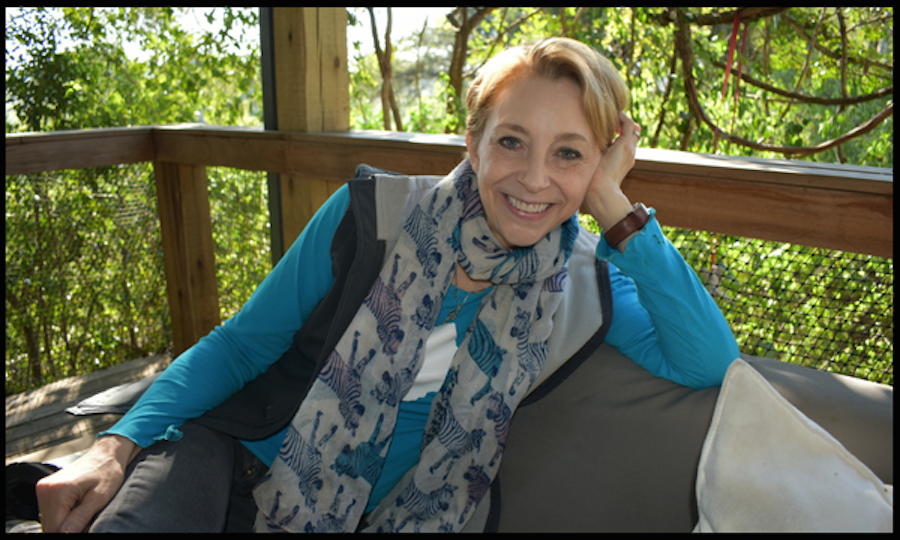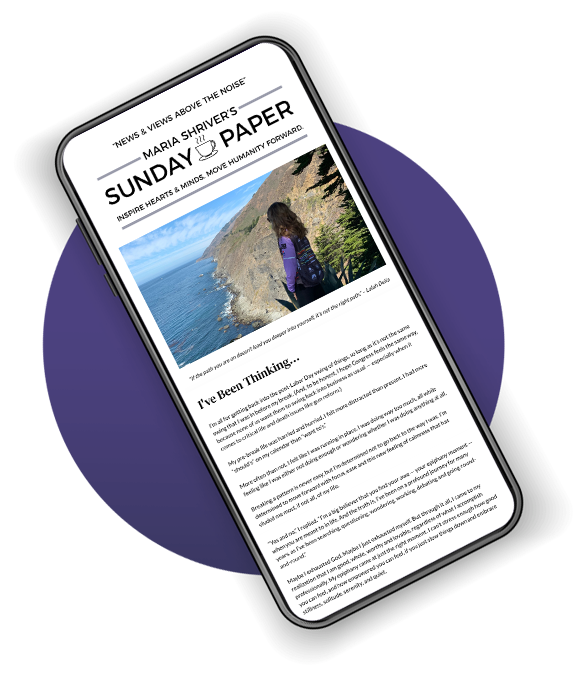When You Trust Yourself, You Live Your Best Life

I’ll tell you this for free: Not all resolutions are created equal. As a new year begins, many of us write lists of noble promises—and break them before the ink dries. Why do most resolutions have so little sticking power? Because they’re what I call “outside-in” goals. They aren’t based on our real, intrinsic desires. We set them because we’ve learned from the culture around us—family culture, religious culture, media culture—that they are Good Things To Do.
By contrast, the kind of new year’s resolution that genuinely improve our lives come from the inside: our hearts, our guts, our cores. They serve our unique nature, not just our culture, so they tend to be motivating and sustainable. But many of us are so besieged by cultural messages that we don’t even know what our inside-out goals might be. Here are some suggestions for reconnecting with your whole self, so you can set resolutions that work.
Step One: Notice what you’re not noticing.
Our brains are similar to those of many other mammals, with one huge exception: the human neocortex. This amazing structure allows us to speak, imagine, calculate—and lie. Humans are better at lying than any other creature on earth. And I don’t just mean deliberate, conscious lying. Our brains are so tuned into social expectations that we often lie to ourselves without even knowing it.
Let me give you an example. When I speak to crowds, I sometimes stop mid-lecture and ask if the audience members are comfortable. They always say that they are. But I press the issue. “Are you sure you’re comfortable?” I ask them. “Are you really, truly comfortable?” At this point the audience members may be a bit annoyed by my weird questions, but they insist that yes, they are absolutely comfortable.
Then I ask, “If you were at home alone right now, how many of you would be sitting in the position you’re in at this moment?”
Virtually no one raises a hand.
“Why not?”
There’s a long pause before a few audience members begin to realize that they’d be in a different position if they were home alone because the position they’re in at the moment is mildly uncomfortable. Now, the problem here isn’t discomfort itself—humans are tough as junkyard dogs; they’ll be fine. The problem is that these people are simultaneously feeling uncomfortable and really believing that they’re completely comfortable.
What these folks really mean is something like: “Given that I’ve been taught since childhood to sit for long periods in uncomfortable chairs, my present discomfort is easy to tolerate.” Their brains put a cultural spin on their actual experience of comfort and discomfort, so that they can lie in clear daylight and not even know they’re doing it.
Most of us do this all day long. We’ve been taught to please our peers, sell our souls to the company store, be silent and subservient, appear tough and unfeeling, or match a million other cultural norms. We usually set resolutions to conform better with social expectations. We don’t even check to see whether our conformity is making us feel more comfortable, or less.
This is a losing strategy, because our fabulous brains aren’t just calculators. They’re mostly animal. Psychologist Jonathan Haidt compares that fancy neocortex to a small human rider on the back of a massive elephant. When we’re being “rational,” we might not even notice how the elephant is feeling. We may try to push our elephant brains in directions they don’t want to go.
Good luck with that.
The only way to make resolutions that work is to create a trusting relationship between our calculating minds (the rider) and our feeling selves (the elephant). Just becoming aware that our verbal minds might be at odds with our deeper feelings is the first step—and you’ve just taken it.
Step Two: Temporarily move away from culture and connect with nature
In one famous series of experiments, groups of subjects were asked to judge the length of three lines. All but one person in the group (the “naive subject”) secretly collaborating with the researchers. These people deliberately stated that two lines were the same length, when this was obviously not the case. Almost a third of the “naive subjects” caved in to group pressure and agreed with the majority. Some of them actually said they began to see the lines differently when they heard other people’s judgments.
With so much vulnerability to social pressure, we’re best able to trust our own perceptions when we’re alone, preferably in nature (no reminders of cultural pressure there). Before you set any important goals, take some time to be alone. Get up a little earlier (or stay up a little later) than the kids, the dog, your constantly-emailing coworkers. Go outside for a walk or sit by a window with a view of trees and sky. Nature loosens the mental straitjackets of culture and gives us space to come home to our whole selves.
Once you’re alone, breathe as slowly and deeply as you can. We hold our real feelings out of awareness (in part) by breathing shallowly and tensing our muscles. Slow, deep breaths tell our animal brains that we’re in a safe place, which triggers relaxation through our whole body-mind. Give in to this relaxation. It is the doorway to your own full awareness, your own real experience.
Step Three: Feel what you feel
I once worked with a Broadway star who told me, “Every day I have to do vocal exercises that involve tons of deep breathing. As soon as I start, BAM! Up come all my feelings. You just can’t breathe that deeply and hold your feelings at bay.” Feeling what’s really going on inside us physically and emotionally is the only way we can connect with our own truth. This is always good, but it isn’t always pleasant.
If you begin feeling difficult emotions like fear, grief, or anger, ground yourself in the actual, physical experience you’re having in the present moment. You can do this any time; in fact, you can try right now. Take a few relaxed breaths, and then notice the physical facts of your situation at this precise moment. Are you sitting, standing, lying down? What does gravity feel like in this position? Is the light bright or dim? What is the taste in your mouth? What’s the temperature of the air?
When you pay close attention to this physical moment, you’ll probably find that you’re okay, even if you also have some difficult emotions on board. If you’re sad, but also sitting in a comfy chair, you can handle that situation—for one moment. If you’re anxious, but also noticing the way a shaft of light is streaming through your kitchen window, you can cope with that one moment as well.
Nature—including the “elephant” self that occupies most of our brains—doesn’t ever get lost in thoughts about past or future. It only has to cope with this one moment. By staying physically connected with our actual, physical reality, we can then make our way, step by step, through even very difficult life circumstances.
Step Four: Take one small step to make your animal self feel better
Research shows that trying to make huge improvements quickly is a recipe for failure. Our elephant selves like to go one small step at a time. So whatever you feel in the moments you’ve reconnected with your whole self, ask this simple question: “What would make me feel a bit better, right now?”
This question works whether things are bad, good, or anywhere in between. If you’re feeling flu-ish and depressed, what small thing could you do to feel better? Call a friend? Take an aspirin? Do it. If anger rises, try punching a pillow or writing down everything that anger needs to say. Feeling joyful and healthy? Dancing to your favorite song or petting the dog might make things even better.
When we take small steps toward feeling better, our elephant selves begin to trust our rider selves. This is the basis of a very powerful team effort.
Step Five: Set goals that make the elephant relax
Once you’ve learned how to connect with your real feelings and move in the direction of feeling better (even a tiny bit better) you’ve got a skill that will take you to the right resolutions. You won’t just make them, you’ll find yourself able to follow them.
Using this skill before committing to anything would make all our lives much easier. Once you’ve taken time away and relaxed your body, hold a goal in your mind. Notice how your body reacts. If it tenses, that’s your elephant brain telling you the goal is wrong for you. If your body continues to relax, the elephant is saying “Yes!”
Use this test to see how big a goal you want to choose, and how fast you want to move toward it. Even a good resolution can frighten the elephant if the scope is too big or the pace is too fast. Keep tweaking your resolutions until you can relax into them. As you move forward, stay alert. Anything that brings fear and tension is almost impossible to sustain. Anything that feels calm and doable will become more and more motivating as you go along.
And repeat
You can use this method not just to make New Year’s resolutions, but to plan each day, each task, each adventure. Get space, relax, notice how a goal affects not just your mind, but your body and emotions. Find ways to move forward gently, ways that keep the “rider” part of your brain in harmony with the “elephant” part. Our culture sees this as odd and wacky. We’ve been socialized to prefer those white-knuckled “rational” resolutions. You can go ahead and use that method. Just check and see if it really, truly makes you comfortable.
My New Year’s wish for all of us is that we become more compassionate and respectful toward every aspect of our inner life. If we do this, we will automatically begin to trust ourselves. And as the poet Geothe once wrote, “As soon as you trust yourself, you will know how to live.”
For more information about Martha Beck, go to marthabeck.com/
This essay was featured in the Jan. 13th edition of The Sunday Paper, Maria Shriver’s free weekly newsletter for people with passion and purpose. To get inspiring and informative content like this piece delivered straight to your inbox each Sunday morning, click here to subscribe.
READ MORE STORIES THAT MOVE HUMANITY FORWARD
READ MORE STORIES THAT MOVE HUMANITY FORWARD
SIGN UP FOR MARIA’S SUNDAY PAPER


